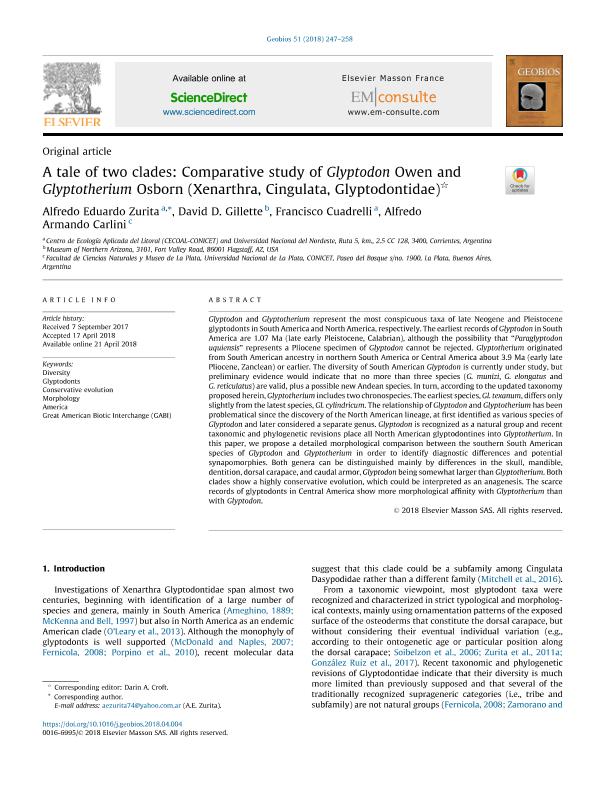Mostrar el registro sencillo del ítem
dc.contributor.author
Zurita, Alfredo Eduardo

dc.contributor.author
Gillette, David D.
dc.contributor.author
Cuadrelli, Francisco

dc.contributor.author
Carlini, Alfredo Armando

dc.date.available
2019-09-13T20:55:15Z
dc.date.issued
2018-06
dc.identifier.citation
Zurita, Alfredo Eduardo; Gillette, David D.; Cuadrelli, Francisco; Carlini, Alfredo Armando; A tale of two clades: Comparative study of Glyptodon Owen and Glyptotherium Osborn (Xenarthra, Cingulata, Glyptodontidae); Elsevier France-editions Scientifiques Medicales Elsevier; Geobios; 51; 3; 6-2018; 247-258
dc.identifier.issn
0016-6995
dc.identifier.uri
http://hdl.handle.net/11336/83593
dc.description.abstract
Glyptodon and Glyptotherium represent the most conspicuous taxa of late Neogene and Pleistocene glyptodonts in South America and North America, respectively. The earliest records of Glyptodon in South America are 1.07 Ma (late early Pleistocene, Calabrian), although the possibility that “Paraglyptodon uquiensis” represents a Pliocene specimen of Glyptodon cannot be rejected. Glyptotherium originated from South American ancestry in northern South America or Central America about 3.9 Ma (early late Pliocene, Zanclean) or earlier. The diversity of South American Glyptodon is currently under study, but preliminary evidence would indicate that no more than three species (G. munizi, G. elongatus and G. reticulatus) are valid, plus a possible new Andean species. In turn, according to the updated taxonomy proposed herein, Glyptotherium includes two chronospecies. The earliest species, Gl. texanum, differs only slightly from the latest species, Gl. cylindricum. The relationship of Glyptodon and Glyptotherium has been problematical since the discovery of the North American lineage, at first identified as various species of Glyptodon and later considered a separate genus. Glyptodon is recognized as a natural group and recent taxonomic and phylogenetic revisions place all North American glyptodontines into Glyptotherium. In this paper, we propose a detailed morphological comparison between the southern South American species of Glyptodon and Glyptotherium in order to identify diagnostic differences and potential synapomorphies. Both genera can be distinguished mainly by differences in the skull, mandible, dentition, dorsal carapace, and caudal armor, Glyptodon being somewhat larger than Glyptotherium. Both clades show a highly conservative evolution, which could be interpreted as an anagenesis. The scarce records of glyptodonts in Central America show more morphological affinity with Glyptotherium than with Glyptodon.
dc.format
application/pdf
dc.language.iso
eng
dc.publisher
Elsevier France-editions Scientifiques Medicales Elsevier

dc.rights
info:eu-repo/semantics/openAccess
dc.rights.uri
https://creativecommons.org/licenses/by-nc-sa/2.5/ar/
dc.subject
America
dc.subject
Conservative Evolution
dc.subject
Diversity
dc.subject
Glyptodonts
dc.subject
Great American Biotic Interchange (Gabi)
dc.subject
Morphology
dc.subject.classification
Zoología, Ornitología, Entomología, Etología

dc.subject.classification
Ciencias Biológicas

dc.subject.classification
CIENCIAS NATURALES Y EXACTAS

dc.subject.classification
Paleontología

dc.subject.classification
Ciencias de la Tierra y relacionadas con el Medio Ambiente

dc.subject.classification
CIENCIAS NATURALES Y EXACTAS

dc.title
A tale of two clades: Comparative study of Glyptodon Owen and Glyptotherium Osborn (Xenarthra, Cingulata, Glyptodontidae)
dc.type
info:eu-repo/semantics/article
dc.type
info:ar-repo/semantics/artículo
dc.type
info:eu-repo/semantics/publishedVersion
dc.date.updated
2019-08-01T21:53:02Z
dc.journal.volume
51
dc.journal.number
3
dc.journal.pagination
247-258
dc.journal.pais
Francia

dc.description.fil
Fil: Zurita, Alfredo Eduardo. Consejo Nacional de Investigaciones Científicas y Técnicas. Centro Científico Tecnológico Conicet - Nordeste. Centro de Ecología Aplicada del Litoral. Universidad Nacional del Nordeste. Centro de Ecología Aplicada del Litoral; Argentina
dc.description.fil
Fil: Gillette, David D.. Museum of Northern Arizona; Estados Unidos
dc.description.fil
Fil: Cuadrelli, Francisco. Consejo Nacional de Investigaciones Científicas y Técnicas. Centro Científico Tecnológico Conicet - Nordeste. Centro de Ecología Aplicada del Litoral. Universidad Nacional del Nordeste. Centro de Ecología Aplicada del Litoral; Argentina
dc.description.fil
Fil: Carlini, Alfredo Armando. Consejo Nacional de Investigaciones Científicas y Técnicas; Argentina. Universidad Nacional de La Plata. Facultad de Ciencias Naturales y Museo; Argentina
dc.journal.title
Geobios

dc.relation.alternativeid
info:eu-repo/semantics/altIdentifier/doi/http://dx.doi.org/10.1016/j.geobios.2018.04.004
dc.relation.alternativeid
info:eu-repo/semantics/altIdentifier/url/https://www.sciencedirect.com/science/article/pii/S0016699517301870
Archivos asociados
